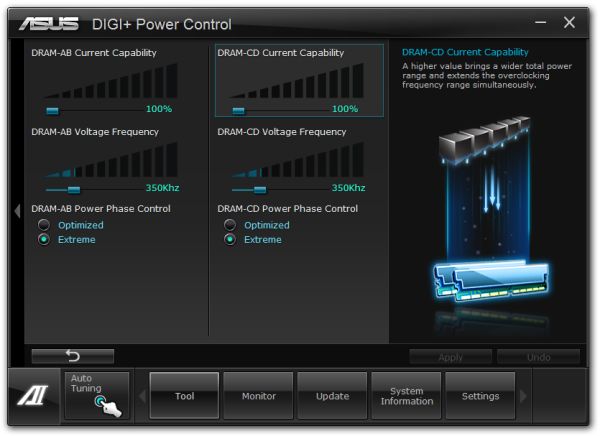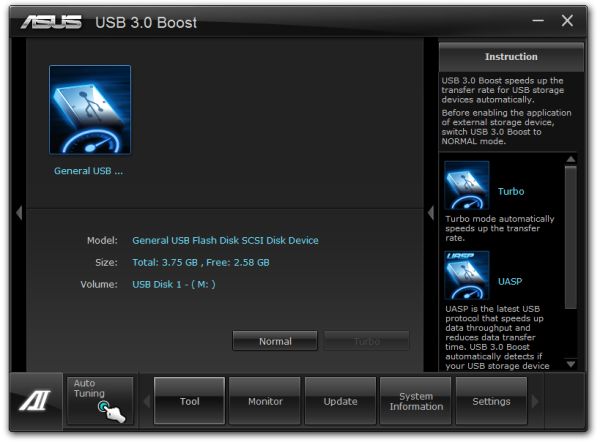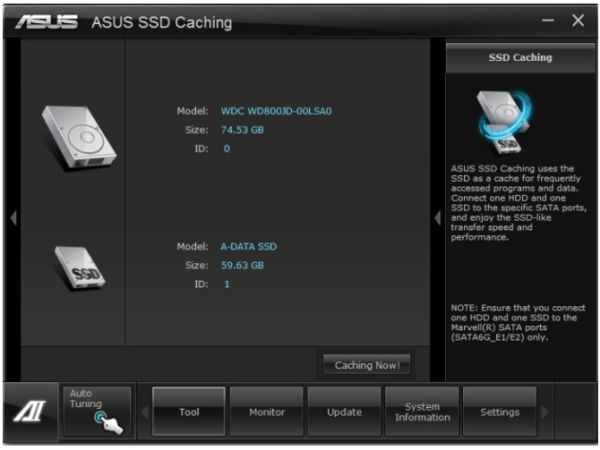Sandy Bridge-E and X79 – The ASUS P9X79 PRO Review
by Ian Cutress on November 14, 2011 3:01 AM EST- Posted in
- Motherboards
- Asus
- X79
Board Features
| ASUS P9X79 Pro | |
| Size | ATX |
| CPU Interface | LGA2011 |
| CPU Support | Intel Second Generation Core i7 Sandy Bridge-E |
| Chipset | Intel X79 |
| Base Clock Frequency | 100.0 - 100.3 MHz |
| Core Voltage | Auto, offset and manual, 0.8 V to 1.7 V |
| CPU Clock Multiplier | Auto, 12x to 57x |
| DRAM Voltage | Auto, 1.20 V to 1.99 V |
| DRAM Command Rate | Auto, 1T to 3T |
| Memory Slots |
Eight DDR3 DIMM slots supporting up to 64 GB Up to Quad Channel Support for DDR3, 800-2666 MHz |
| Expansion Slots |
2 x PCIe Gen 3 x16 2 x PCIe Gen 3 x8 2 x PCIe Gen 2 x1 |
| Onboard SATA/RAID |
2 x SATA 6 Gbps, Support for RAID 0, 1, 5, 10 4 x SATA 3 Gbps, Support for RAID 0, 1, 5, 10 |
| Onboard |
2 x SATA 6 Gbps (Marvell) 4 x SATA 3 Gbps (PCH) 2 x SATA 3 Gbps (PCH) w/ SSD Caching 6 x Fan Headers 1 x Front Panel Header 1 x Front Panel Audio Header 1 x S/PDIF Out Header 4 x USB 2.0 Headers 1 x USB 3.0 Header 1 x EPU Switch 1 x TPU Switch Power / Reset / Clear CMOS Buttons + Debug LED |
| Onboard LAN | Intel Gigabit 82579V |
| Onboard Audio | Realtek ALC898 |
| Power Connectors |
1 x 24-pin ATX connector 1 x 8-pin 12V connector |
| Fan Headers |
2 x CPU Fan Header 4 x Chassis Headers |
| IO Panel |
6 x USB 2.0 4 x USB 3.0 1 x BIOS Flashback Button 1 x Intel Gigabit Ethernet 1 x Optical S/PDIF Out Connector 2 x Power eSATA 6 Gbps Bluetooth v2.1 Audio Jacks |
| BIOS Version | 0709 |
| Warranty Period | 3 Years |
The Intel NIC is very welcome on a high end platform, as well as one of the later models of Audio Codec by Realtek, which is represented in the DPC Latency performance. The BIOS Flashback feature (Update BIOS via USB without CPU or DRAM) is an excellent feature I hope ASUS ports to all future chipsets, as well as the SSD Caching option even though it is not part of the X79 specifications. Six fan headers is always good, as well as Debug LED and power/reset buttons, however as mentioned previously I would have liked another Ethernet port.
As always, ASUS motherboards have a 3 year warranty.
In The Box
IO Shield
Manual
Driver CD
1 x Long SLI Cable
1 x Rigid Tri-SLI Connector
6 x SATA cables, locking, right angled
Q-Connectors
While ASUS have spent money on the cables and the SLI connectors, on a product at this price, I would have liked to see a long CrossFireX cable and a USB 3.0 front bracket.
Software
Software installation, as always with ASUS, is straightforward. Clicking Install-All on the CD menu under the Driver section does the drivers, and then once again under the Software for software. ASUS bundles Google Chrome and Norton Antivirus with the CD as well which annoyingly ask to be installed – users have to deselect them if they do not want them. Daemon Tools Pro is also on the CD, though users have to install it individually.
The main stalwart of ASUS software is still here, under a slightly redesigned ASUS AI Suite II. With the depth of X79 and all the new features ASUS have added, we have to get to grips with the whole software. Overclocking function is nothing spectacular here, with Auto Tuning and slider adjustment being identical to previous implementations. With the advent of DIGI+ VRM for the memory, we now get options to adjust this, as well as the DIGI+ for the CPU.
Energy efficiency options also get a revamp in their modes, and in terms of fan controls, each of the four chassis fan headers are double-ramp adjustable, and the two CPU fan headers act under the one control.
The two new areas of ASUS brand technology come in the form of ASUS USB 3.0 Boost, and ASUS SSD Caching. Let us go over each one in turn.
ASUS USB 3.0 Boost
Readers of this year’s content may cast their minds back to the several ASRock boards I have reviewed, and their XFast USB software. This was a simple bit of software that modified and optimized the Windows7 USB driver to allow for faster operation. ASUS have gone in a similar theme, but taken it several steps further.
On the simple end, there are multiple USB protocols to use. Windows, by default, uses BOT – a simple linear process protocol for file transfer. By a simple rewrite of the driver, such as the ASRock implementation, a motherboard manufacturer can implement a ‘Turbo’ mode, which acts like a more multithreaded environment.
Now, if the USB device or enclosure has certain classes of controllers (LucidPORT USB300-REV2, ASMedia ASM1051E, ASMedia ASM1051U, ASMedia ASM1054), a protocol known as UASP (USB Attached SCSI Protocol) can be implemented. This protocol is more efficient, and allows multiple, concurrent commands, rather than the linear BOT sequence. This is what USB 3.0 Boost is aimed at.
Initially, each USB 3.0 device will need to be set to Turbo or UASP as required, but devices are remembered for repeat use. Unfortunately, I do not have access to a device to test this UASP performance; however I was able to see it in action at a recent ASUS event.
ASUS SSD Caching
Users of Intel’s Z68 Smart Response Technology that were dismayed when SRT was not a part of the X79 specifications will be overjoyed to see something similar to Intel’s operation on ASUS’ X79 range. By placing two compatible drives (typically a mechanical HDD and a formatted SSD) in the appropriate SATA ports, the software and hardware implementation will let the SSD act as a cache, in order to improve loading times to the mechanical HDD, just like Intel’s RST.
The potential here is possibly using any extra RAM as a cache. With the abundance of 4x4GB kits for use in such a system, from my own personal experience, almost half of that would never be used – the most memory I’ve ever used is 7.9 GB, which included a hundred or so internet tabs, background software, and whilst playing F1 2010 at full settings. If ASUS were to license a RAMDisk software technology to allow users to create a RAMDisk, and then use that in an SSD caching technique, then we are on to a winner. Even better if a user has decided to fill up the memory slots with 32 GB. Admittedly, this would be lost every time the system is rebooted, and would have to be remade, but for users who leave their system on all the time for various reasons, it could provide useful.





















55 Comments
View All Comments
buildingblock - Monday, November 14, 2011 - link
Amongst all the other goodies, the outstanding feature for me is the BIOS fan control. Well done to Asus, this board has probably the best PWM based fan control yet. Other board makers, particularly GigaByte, please take note.ASUSTechMKT - Monday, November 14, 2011 - link
Thanks so much for the feedback. We have been working hard to consistently improve in the quality of fan controls. Kudos to Ian for taking the time to detail it as well. This is somethign we have to take more time in the development ( Super I/O controller and frmware and software ) but any serious enthuiast can appreciate the additional functionality and increased usability.Thanks again!
jigglywiggly - Monday, November 14, 2011 - link
am i the only one kind of dissapointed? No integrated gpu is lame, also not that much faster.Kougar - Monday, November 14, 2011 - link
Holy moly, $330 for just the Pro?Given the extreme prices involved here, I'd especially like to know the key differences between the Pro and the Deluxe models, and even the Pro and the vanilla model as well.
ASUSTechMKT - Monday, November 14, 2011 - link
DeluxeOffers BT3.0 with Wifi, Additionally USB3, Dual Lan, A more advanced VRM heatsink assembly,
In regards to the pricing it is important to remember many of the additional items incorporated have a higher cost ( such as the hardware required to allow for UEFI flashing with CPU, Memory or a Graphics card this required a hardware level IC, the more advanced super I/O controller with more advanced fan controls for all the headers ) These additional touches add to the total cost of the board.
Kougar - Monday, November 14, 2011 - link
Thank you for the reply!For anyone else curious, after some digging I can say that in addition to the above, P9X79 Vanilla also loses the Marvell controller and associated SATA 6Gb/s ports. The Realtek sound chip also changes from a 898 to the 892, not sure what the difference is. The PWM phase design appears to remain unchanged between the vanilla and PRO models, while the Deluxe doubles the CPU & uncore phases.
Somewhat oddly, the P9X79 also gains a firewire port over the PRO model.
ASUSTechMKT - Wednesday, November 16, 2011 - link
Yes as you go up the boards you will also have more USB 3 (as the PRO has more USB which makes sense as 1394 is a legacy standard). Main reason it is offered on the Standard is that this model is adopted by sometimes business or professionals you still need some legacy connections.In regards to the overall VRM design we use the same high quality dual N mosfet package on all three boards and advanced driver this aligns with the high amperage rated choke. While the "phase" is increased on the Deluxe this only helps to slightly improve balancing of the VRM otherwise the performance for overall power delivery is rated the same. (Although the advanced heatsink design as you move up will help to ensure a cooler operating temperature for the VRM assembly.
Hope it helps!
Filiprino - Monday, November 14, 2011 - link
There was a rumour saying ASUS would release a dual socket LGA2011 motherboard to compete with EVGA SR-3. Any news?Kougar - Monday, November 14, 2011 - link
The board exists, but I haven't seen anything about it so far. Very curious to see it and the EVGA SR-3 compared, even if just to drool over!ASUSTechMKT - Wednesday, November 16, 2011 - link
Sorry cannot comment on that one......